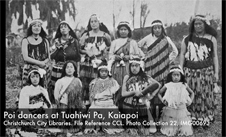Ngāi Tūāhuriri and Waitaha, who were in these lands when Ngāi Tūāhuriri arrived, imbued the natural landscape and world around them with stories of gods and ancestors. As you stand here and listen to a couple of these stories, feel your connection to each landmark grow. Put yourself into Te Ao Māori and begin to understand that the whenua has its own life force, and each part has a story to tell.
 If you are standing here in Spring or Summer, there is a good chance you are feeling the North-‐West wind blowing. A mighty wind, it blows warm and relentless, and is notorious among Cantabrians for causing headaches and general irritability. Waitaha people knew this wind as Te Māuru, and Ngāi Tahu have been said to have referred to it as "Te Hau Kai Tangata" – "the wind that devours humankind."
If you are standing here in Spring or Summer, there is a good chance you are feeling the North-‐West wind blowing. A mighty wind, it blows warm and relentless, and is notorious among Cantabrians for causing headaches and general irritability. Waitaha people knew this wind as Te Māuru, and Ngāi Tahu have been said to have referred to it as "Te Hau Kai Tangata" – "the wind that devours humankind."
Turn to the West, and try to discern the peaks of the Southern Alps in the distance. These peaks represent the sons of Raki, sky father, who journeyed down from the heavens to meet earth mother Papatuanuku. Their canoe, known as a waka, capsized as they tried to make their way back, and the hull of the waka became the South Island. The brothers clambered on top of the overturned waka and there were frozen by the icy Southerly wind, and turned to stone. The tallest of the brothers was Aoraki, and he stands high and proud, the tallest peak in Aotearoa.
Communications networks and cell towers were entirely unreliable in Ōtautahi following the earthquakes. Power was cut off to many homes, some for periods of weeks, and with the decrease in landline phones people found themselves virtually cut off. Organisations such as the Student Volunteer Army and Comfort for Christchurch worked to provide some relief to those worst affected, and all over the city, people were meeting their neighbours for the first time as news relied on word of mouth to travel to the people who needed it.
 Much as news was passed from neighbour to neighbour in post-quake Christchurch, the stories and traditions of Ngāi Tahu have always been passed on in the same way, through oral storytelling, from generation to generation. The living arrangements of Iwi, hapu and whanau were a perfect structure for this kind of organic information sharing. With the signing of Kemp's Deed, the disruption to these social structures will surely have impacted the ability to share stories, leading to lost history, and colonisation has led to a devastating loss of language.
Much as news was passed from neighbour to neighbour in post-quake Christchurch, the stories and traditions of Ngāi Tahu have always been passed on in the same way, through oral storytelling, from generation to generation. The living arrangements of Iwi, hapu and whanau were a perfect structure for this kind of organic information sharing. With the signing of Kemp's Deed, the disruption to these social structures will surely have impacted the ability to share stories, leading to lost history, and colonisation has led to a devastating loss of language.
Think of Aoraki (Mt Cook), a tall peak, staunch and proud. This is how Ngāi Tahu and Ngāi Tūāhuriri stand – tall, and with great mana - refusing to lay down and accept injustice. Ngāi Tahu and Ngāi Tūāhuriri have shown great strength, determination and resilience through many generations to not only preserve, but to build and evolve their Iwi into a smart, modern, economic force, while upholding the proud traditions of their ancestors.